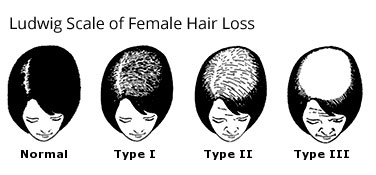Women’s Hair Loss Classification: The Ludwig System
Women’s hair loss is much less well understood than men’s hair loss. When a woman shows hair loss, it is very common that hair loss was present among other women in her family. Since genetic hair loss presents itself differently in women and men, doctors use the Ludwig system to classify the type of women’s hair loss they are experiencing rather than using the Norwood scale, which is used for men. The Ludwig scale was created for doctors treating women struggling with Androgenetic Alopecia (genetically related hair loss). The purpose of the Ludwig Scale is to measure female hair loss and determine the most appropriate women’s hair loss treatment or women’s hair restoration method.
Ludwig Classification of Women’s Hair Loss
 Scale I: Hair is beginning to become thin and diffuse. However, it is very difficult for anyone except for the woman herself to notice. This is the perfect time to begin taking serious and conscientious methods to employ better hair and scalp care. This may include refraining from using high heat blow-dryers and curling irons. You may also consider purchasing appropriate shampoo and conditioner for your hair and scalp type. This is also the time when you should pay your doctor a visit.
Scale I: Hair is beginning to become thin and diffuse. However, it is very difficult for anyone except for the woman herself to notice. This is the perfect time to begin taking serious and conscientious methods to employ better hair and scalp care. This may include refraining from using high heat blow-dryers and curling irons. You may also consider purchasing appropriate shampoo and conditioner for your hair and scalp type. This is also the time when you should pay your doctor a visit.
Scale II: Women have lost approximately 50% of their hair when they reach Stage II. Hair loss is noticeable both to the woman herself and to others. At this stage, visiting your doctor is an absolute must. It is critical that a physician is able to collect a medical history and perform tests to rule out more serious conditions. At this point, you may also consider various hair replacement options such as an approved laser hair loss treatment program, a hair prosthesis, wigs, or hair replacement solutions that fit with both your lifestyle and preferred hairstyle.
Scale III: When women are classified as Grade III it means that their hair is widening significantly where the part is present. Hair loss at stage three is very obvious and the scalp is visible. Baldness is difficult to cover with natural hair and often a hair system is necessary for women who are uncomfortable with baldness. If you’ve already seen your doctor, you could consider paying him/her another visit to revisit medication options. Also, meeting with a hair replacement specialist is helpful at this point since modern, state-of-the-art hair replacement solutions exist which are totally undetectable, even up close. This may be especially important for the woman who wants to lead a happy, productive, and public life.
Scale IV: At this point, there is more visible scalp than hair. Medications that haven’t yet worked will likely not work. Hair loss is at its most severe during stage four and medical interventions have failed to restore your hair. If your hair loss is at this stage, then it’s time to move into a conversation about wigs and hair prostheses.
Why Classify Women’s Hair Loss
Many women wonder why they should want to classify their degree of hair loss using the Ludwig scale. Women’s hair loss is hair loss, right? Not quite. The information that the scale provides can help to inform your next move. The more information you know about your hair loss, the better prepared you will be to understand and determine the most appropriate women’s hair replacement options for you, based on the degree of hair loss you are experiencing, and what the best course of action is to restore your hair and get back what you’ve been missing.
- Digital Detox for Your Mind & Scalp: Reclaiming Wellness from Inside Out - December 14, 2024
- October: Breast Cancer Awareness Month - October 3, 2024
- Effects of Chlorine on Thinning Hair - June 2, 2024





